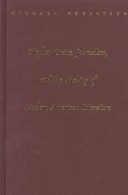Born in 1871, Stephen Crane came of age when the mass-circulation newspapers began to attract readers with stories about urban life that resembled realist fiction. Although Henry James and William Dean Howells attacked the "new journalism" for blurring the boundary between newspaper and novel, younger writers like Crane, Willa Cather, and Katherine Anne Porter began to play the role of journalist as literary artist. When Crane's The Red Badge of Courage was published in 1895, it was a revelation to readers: as H. L. Mencken said, the book's release "lifted newspaper reporting to the level of a romantic craft, alongside counterfeiting and mining in the Klondike".Michael Robertson presents the first critical study of Stephen Crane's journalism and the broad climate of change that had begun to blur the line between nonfiction writing and fiction in Crane's era. Robertson provides fascinating insight into the masculine aesthetic Crane championed in his urban reportage, travel writing, and war correspondence, in contrast to an increasingly popular feminized image of artists and writers. Robertson also explores the life and work of two writers directly influenced by Crane: Ernest Hemingway and Theodore Dreiser.
In this lucid cultural history, Robertson goes beyond biography and literary criticism to trace a literary revolution that, as little studied as it has been, is a resonating strain in the genealogy of modern American literature.
- ISBN10 0231109687
- ISBN13 9780231109680
- Publish Date 1 December 1997 (first published 6 November 1997)
- Publish Status Active
- Out of Print 8 November 2001
- Publish Country US
- Imprint Columbia University Press
- Format Hardcover
- Pages 264
- Language English
